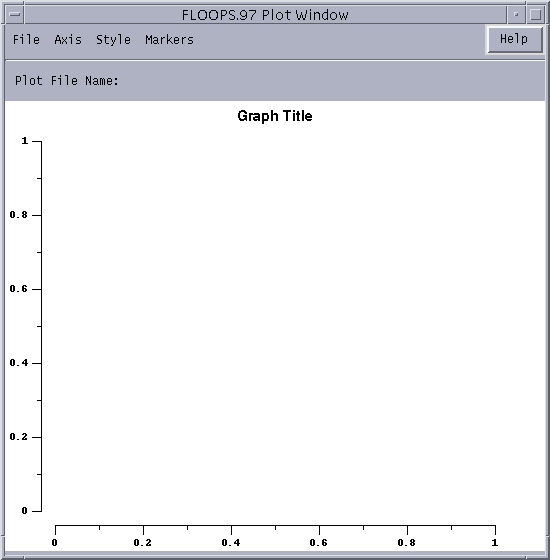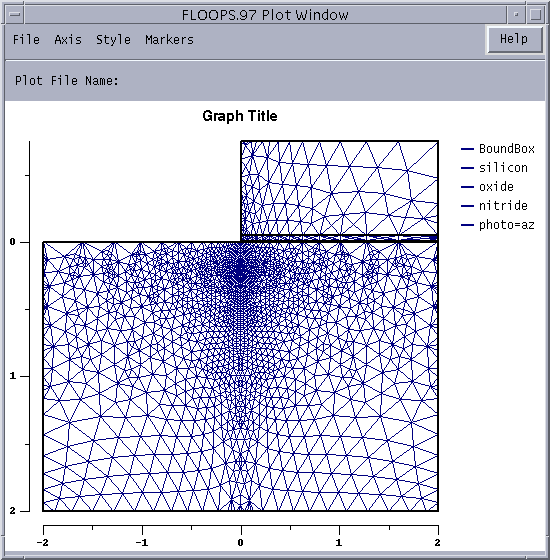Plot Examples
Contour and Color Plots
A structure is created with the following set of commands:
Grid2D [pselectCommandl sel]] z=1.0e17 name=Boron store implant arsenic dose=1.0e15 energy=20 strip photo=az diffuse time=5 temp=1100 dry set Win[ CreateGraphWindow]
The variable Win now contains the contact information for the plot window. The window will look like:
The next set of commands adds the material boundaries.
foreach m mater { CreateBound $Win $m [ bound $m] }
Flipy $Win 1
The abouve section of commands duplicates the old style "plot.2d bound" command. The plot window looks:
sel z = { Boron-Arsenic } CreateLine $Win Junction [ slice silicon val = 0.0]
These two commands select the net doping and then plot a contour line along the material junction.
sel z = { log10(abs( Boron-Arsenic) ) } for {set i 18} {$i <= 20.0} {incr i} { CreateLine $Win $i [ slice silicon val = $i] }
This set puts isoconcentration lines on the plot. After changing the line style for the various elements, and selecting fill for the oxide and nitride. These options are selected in the BLT plot window. The final graph looks like :
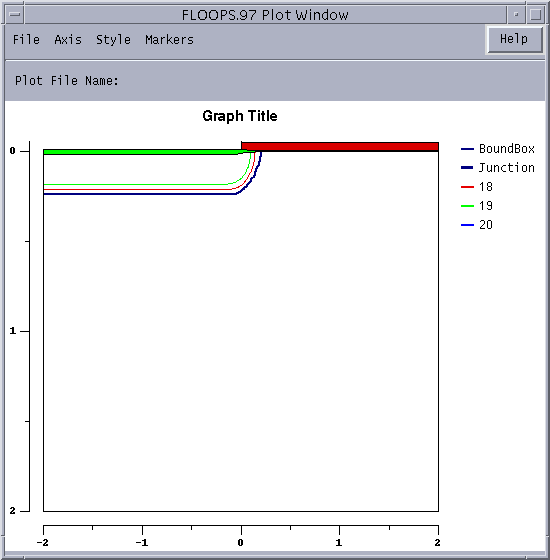
One-Dimensional Plots
Using the same structure as before, we can perform depth plots through several regions of the device.
ClearGraph $Win sel z=Boron CreateLine $Win Boron [ slice silicon y = -2.0] sel z=Arsenic CreateLine $Win Arsenic [ slice silicon y = -2.0]
This code section will draw the boron and arsenic concentrations at the left edge of the device. Both lines are on the same plot.
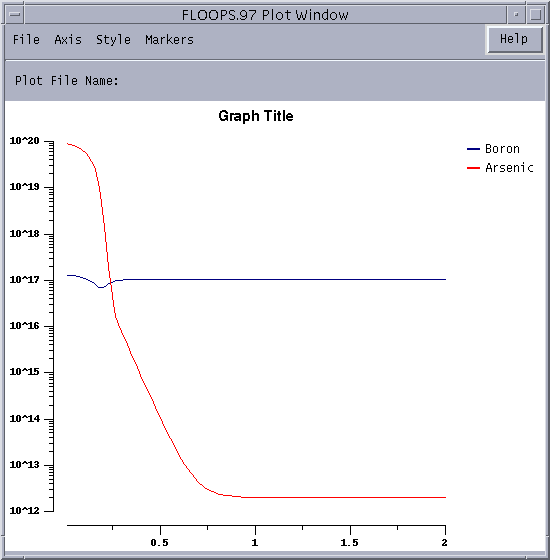
Grid Plot
We create a structure with an interesting grid using the commands:
Grid2D
foreach m [mater] {Smooth $m}
This smooths each region of the mesh.
foreach m [ mater ] { CreateBound $Win $m [ bound $m] } FlipY $Win 1
This code section outlines each section. The grid can be plotted using a combination of the element command and the CreateLine command.
foreach m [ mater ] { CreateBound $Win $m [ element $m] }
Each material has its grid added to the plot. After some property editing, the plot looks like:
XGraph Window Examples
Contour and Color Plots
A structure is created with the following set of commands:
Grid2D [select.html sel] z=1.0e17 name=Boron store sel z=1.0e15 name=Arsenic store [../floops/implant.htm implant] arsenic dose=1.0e15 energy=20 [../floops/strip.html strip] photo=az [../floops/diffuse.html diffuse] time=5 temp=1100 dry
The plot is created with:
[plot.2d.html plot.2d] bound fill
[select.html sel] z = Boron-Arsenic
[contour.html contour] val = 0.0
[select.html sel] z = log10(abs(Boron-Arsenic))
for {set i 15} {$i <= 20.0} {incr i} {
[contour.html contour] val = $i
}
This code section will draw the [plot.2d.html outline] of the device and stretch it to fill the plot window. The next line [select.html selects] the doping concentration and [contour.html plot]s a line along the metallurgical junction. Then plot variable is selected to the log base 10 of the absolute doping concentration. A loop from 15 to 20 follows with [contour.html contour] lines being drawn each decade for both p- and n-type doping. The resulting plot: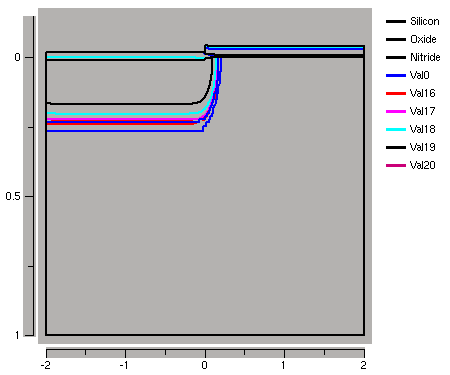
One-Dimensional Plots
Using the same structure as before, we can perform depth plots through several regions of the device.
[select.html sel] z=log10(Boron) [plot.1d.html plot.1d] y=-2.0 [select.html sel] z=log10(Arsenic) [plot.1d.html plot.1d] y=-2.0 !cle
This code section will draw the boron and arsenic concentrations at the left edge of the device. Both lines are on the same plot: 
